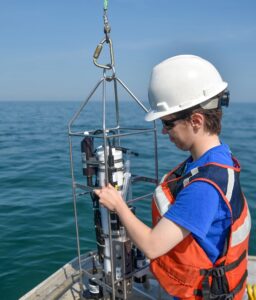
By Lester Graham, Michigan Radio
The Great Lakes News Collaborative includes Bridge Michigan; Circle of Blue; Great Lakes Now at Detroit Public Television; and Michigan Radio, Michigan’s NPR News Leader; who work together to bring audiences news and information about the impact of climate change, pollution, and aging infrastructure on the Great Lakes and drinking water. This independent journalism is supported by the Charles Stewart Mott Foundation. Find all the work HERE.
For two decades, scientists have been studying toxic cyanobacterial blooms in the western basin of Lake Erie. All those data reveal that it’s an incredibly complex situation that’s constantly changing and there are no easy solutions.
After loading sampling equipment on an unnamed National Oceanic and Atmospheric Administration (NOAA) boat identified only as R4108, researchers cruised out of a marina in Monroe, Michigan for another round of sampling on Lake Erie.
Two of the researchers onboard are from the University of Michigan’s Cooperative Institute for Great Lakes Research —everybody just calls it CIGLR.

Paige Williams with CIGLR guides a sampling device which is lowered into Lake Erie by crane. (Photo Credit: Lester Graham/Michigan Radio)
They go out every week during the summer to see what’s happening in the water that’s causing the bright green cyanobacterial blooms.
“Sampling as much as we do, we’re building up a knowledge base of the physical and biological parameters that are in the western basin,” said Andrew Camilleri, a lab specialist who spends most of his time in the field.
He and Paige Williams pulled water samples from eight spots in the lake.
Another researcher, Karl Bosse with Michigan Tech Research Institute, sampled the optical properties of the water, seeing how light interacts with the water. That information helps with imaging from orbiting satellites.
Several agencies and organizations from the U.S., Canada, Michigan, Ohio, Pennsylvania, and New York have been gathering information for years. This effort is necessary because in recent decades, the cyanobacterial blooms have been expanding in the western basin of Lake Erie and elsewhere. Dead zones have been found in the central basin.
The nutrient pollution that causes it, primarily from agriculture, is not regulated.
According to the Centers for Disease Control, exposure to cyanobacterial toxins can irritate your skin, eyes, nose, throat, and lungs. The toxins can also cause liver damage in people and animals. Every year, there are reports of dogs dying from exposure after swimming in Lake Erie or other bodies of water in the U.S.
So, everyone want to reduce the size of these blooms, but how much data do the scientists really need to find the right approach?
“I don’t think there’s such a thing as too much data,” Camilleri said, laughing at the question.
Camilleri and Williams will take their Lake Erie water samples to NOAA’s Great Lakes Environmental Research Lab (GLERL) in Ann Arbor.

Ashley Burtner is the lab site manager for the Algal Bloom Monitoring program. She works for the University of Michigan’s CIGLR, but works in the NOAA Great Lakes Environmental Research Laboratory. (Photo Credit: Lester Graham/Michigan Radio)
There, Ashley Burtner with CIGLR is the lab manager for this work. She said all those samples are helping them to understand an ever-changing situation in Lake Erie.
“If you have one week of data, it’s not going to tell you anything. If you have a summer of data, it’s going to tell you more. But the next summer could be completely different,” she said.
Lab workers go through the previous week’s samples, determining the nutrient levels and other factors that determine the growth of the cyanobacteria blooms.
Besides looking at what is feeding cyanobacteria, the data gathered from the samples help researchers learn more about the toxicity of the blooms.
“Cyanobacteria are a natural part of the community. The problem is, is that there’s something out of balance,” said Reagan Errera, a research ecologist with NOAA.
She said part of the reason we’re seeing more cyanobacteria is because of how farms operate. Crops need phosphorus. Large livestock farms have lots of manure that’s rich in phosphorus. After it’s spread on fields as fertilizer, some of it washes into streams and rivers that flow into Lake Erie.
“So phosphorus is going to increase the number of cells that are present that then can increase the amount of toxin that’s present,” Errera explained.

Reagan Errera, research ecologist with NOAA. (Photo Credit: Lester Graham/Michigan Radio)
Larger blooms mean larger areas producing toxins. But the sheer amount of cyanobacteria is just the beginning. There’s also the level of toxicity in some strains of cyanobacteria.
Errera showed me a collection of different strains in another GLERL lab. There are dozens that have been identified. Some produce toxins. Others don’t.
Some of the samples have been collected and identified by Gregory Dick. He is a professor at the University of Michigan. He’s also the Director of CIGLR.
“The toxin requires high concentrations of nitrogen and therefore the toxic strains have a higher nitrogen demand,” Dick said in his office, as he explained a more recent area of research.
That nitrogen is also supplied by agriculture. One of the ways is through commercially produced urea-based nitrogen. It’s used as a supplement in cattle feed and lately in other ways.
“Increasingly, urea is also being used as a fertilizer, so that contains a large amount of nitrogen. And then the other big source would be animal waste,” Dick said.
Urea is found in urine, so that animal waste is contributing to the toxicity in some cyanobacteria.
“Determining the factors that affect toxicity is still an active area of research,” he added.

Karl Bosse with Michigan Tech Research Institute measures the how light interacts with water in Lake Erie. The data is important to satellite imaging. (Photo Credit: Lester Graham/Michigan Radio)
Sunlight and what’s called reactive oxygen species, which are highly reactive chemicals such as hydrogen peroxide that is produced naturally in the lake, might also increase toxicity. So can temperature. High temperatures can make cyanobacteria grow faster, but cooler temperatures can cause an increase in toxin production.
The current state of the lake because of invasive quagga and zebra mussels is a factor. Those mussels have filtered out microscopic plant life, phytoplankton, which could compete with cyanobacteria for those nutrients. It also makes the water more clear, allowing sunlight to penetrate more deeply into the water.

Gregory Dick is the Director of the Cooperative Institute for Great Lakes Research at the University of Michigan. He said research is finding there are complexities in what causes certain strains of cyanobacteria to increase toxin production. (Photo Credit: Lester Graham/Michigan Radio)
Climate change-driven intense rain storms wash the phosphorus and nitrogen that’s stored in upstream creeks and ditches into the lake, making predictions about the cyanobacteria bloom difficult. Weather also plays a factor. This year, May was dry so the forecast was for a smaller than average bloom. But cyanobacterial blooms were detected earlier in the summer than usual in Maumee Bay at Toledo, Ohio.
Plus, climate change means more carbon is dissolving into the lake and that also can feed cyanobacteria, encourage the production of toxins, as well as increase the acidity of the lake.
The many strains of cyanobacteria respond differently to all those inputs, and researchers are still teasing out just how many strains there are and how many of them produce toxins.
The nutrient that’s most abundant and leads to large cyanobacterial blooms is phosphorus.
The U.S. Environmental Protection Agency is pushing Ohio and Michigan to reduce phosphorus pollution by 40 percent by 2025. Neither state is on track to meet that goal.
Getting that phosphorus reduction is based on government agencies offering money to farmers to voluntarily take measures to reduce that one kind of pollution.
Some farmers are doing that. So far, not enough of them.
“We can’t rely on simply incentives. We need to address the problem and look at the sources of nutrients in a way that is much more accountable,” Dick said.
Because of the massive amount of nutrients that have been washed into ditches, streams, and rivers, much of it is stored in soil in the banks and beds of the streams. Even if the actual amount of phosphorus being used is reduced by 40 percent in the next few years, there’s still phosphorus going into the system. It’s likely it will be decades before the already stored nutrients are flushed into Lake Erie.
And even that possibility comes with a caveat: there’s a lot we don’t know about these toxic cyanobacteria. Maybe the cyanobacterial blooms will be smaller, but will what’s left increase production of toxins because of other nutrients or because of other environmental changes? Will people be at greater risk if they live near the lake, or fish in it, or play in Lake Erie?
The scientists say more research is needed.
Catch more news at Great Lakes Now:
New federal money is the start of an effort to make Great Lakes coasts more resilient
Preparing for a Great Lakes oil spill
Featured image: Andrew Camilleri fills a vial with a sample of water taken from Lake Erie. He’s part of a multi-faceted effort to monitor the changes affecting toxic cyanobacterial blooms. (Photo Credit: Lester Graham/Michigan Radio)




